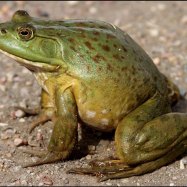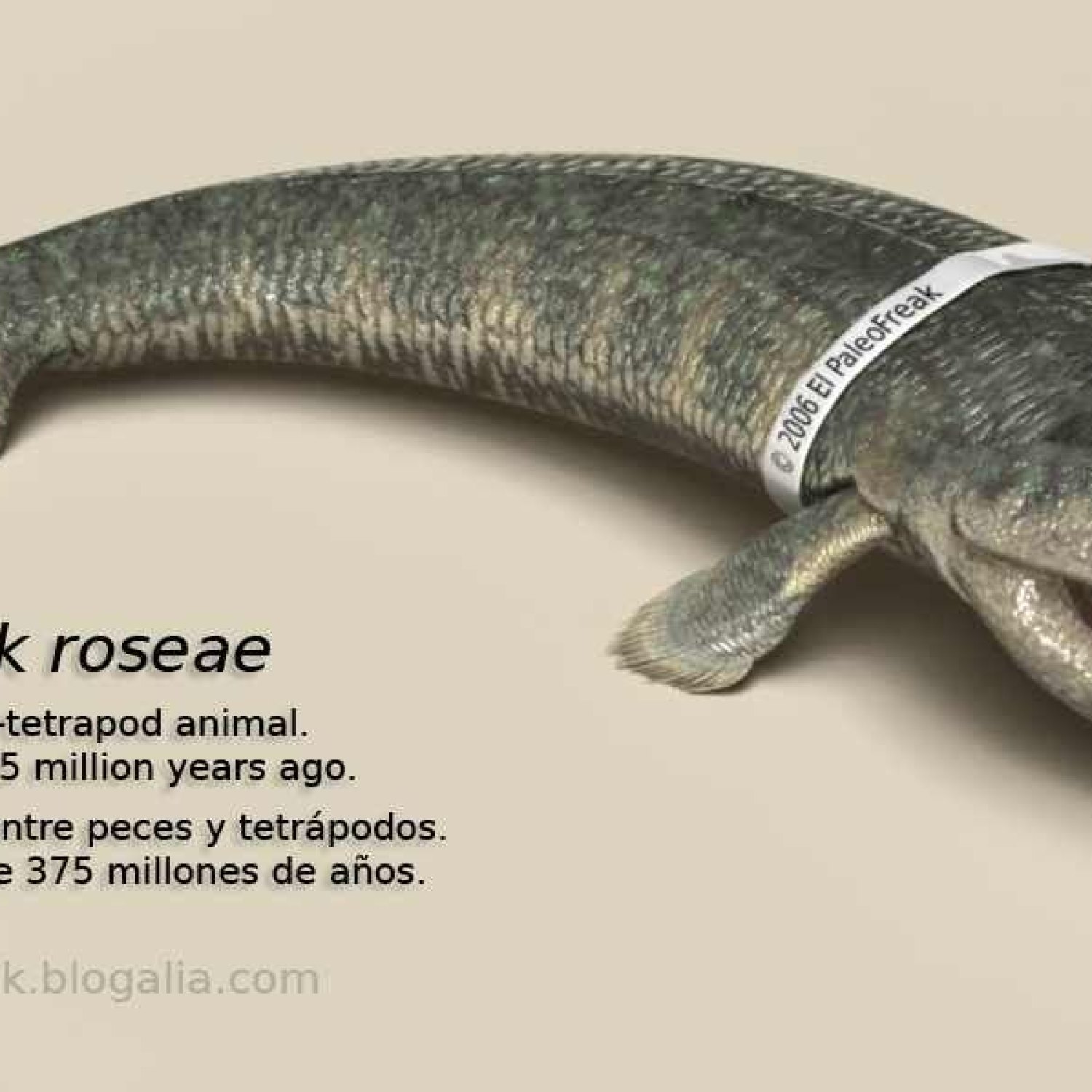
Tiktaalik
Approximately 9 feet
Tiktaalik, a prehistoric animal from the fish family, was discovered in Ellesmere Island and had a unique body shape that resembled a fish with limb-like fins. They were approximately 9 feet in length and are believed to have been an important link between fish and land animals during the evolution process. #Tiktaalik #prehistoricanimal #evolution #EllesmereIsland
Animal Details Summary:
Common Name: Tiktaalik
Kingdom: Animalia
Habitat: Freshwater
The Remarkable Tiktaalik: A Fascinating Transitional Fossil from Arctic Canada
The world of paleontology is full of incredible discoveries and fascinating creatures. However, some discoveries stand out above the rest, especially when they bridge the gaps in evolution and provide insight into the origins of different species. One such discovery is Tiktaalik, a remarkable transitional fossil that offers a window into the evolutionary journey of vertebrates. This prehistoric creature is truly one of a kind, and its story is nothing short of captivating Tiktaalik.Unveiling Tiktaalik
Tiktaalik, whose scientific name also happens to be its common name, is an extinct genus of sarcopterygian (lobe-finned) fish that roamed the Earth more than 375 million years ago during the late Devonian period. It is believed to have existed around the time when fish first began to develop limbs and take their first steps onto land, marking a significant milestone in the evolution of terrestrial vertebrates.This transitional fish species was first discovered in 2004 by renowned paleontologist Neil Shubin and his team in the Canadian Arctic, on Ellesmere Island. It took more than a decade to completely excavate and study the fossils due to the harsh weather conditions on the island and the remote location of the site. But when the team finally unveiled the complete specimen, Tiktaalik took the scientific world by storm.
Family Ties
Tiktaalik belongs to the class Sarcopterygii, which includes all known lobe-finned fish. It is the closest relative of tetrapods, which are four-limbed vertebrates, including humans. Tetrapods are believed to have evolved from lobe-finned fish, making Tiktaalik an important transitional species in our evolutionary history.Interestingly, Tiktaalik is also its own family, with no direct descendants Tully Monster. This means that there were no other similar species of this genus and that it represents a unique and distinct evolutionary branch.
Aquatic Lifestyle
Tiktaalik was a freshwater fish that lived in the rivers and lakes of Arctic Canada. During the late Devonian period, the Earth was much warmer, and the climate in the Arctic was more humid and subtropical, providing an ideal habitat for this species. The warm waters would have been teaming with life, making it easy for Tiktaalik to find food and thrive.Like most fish, Tiktaalik had gills to extract oxygen from the water. However, what makes it unique is that it also had primitive lungs, which it would use to supplement the gills when the water levels were too low or oxygen levels were too low. This feature would have allowed Tiktaalik to survive in varying water conditions, making it a highly adaptive species.
Predatory Habits
Tiktaalik was a predator, using its sharp teeth and agile body to hunt for food. Its diet would have been primarily made up of arthropods, small fish, and other aquatic creatures found in its freshwater habitat. Its long snout and powerful jaws would have allowed it to catch and consume its prey with ease.However, what makes Tiktaalik's feeding method truly remarkable is its unique body shape. While it had a fish-like body, it also had limb-like fins, making it somewhat of a hybrid between a fish and a tetrapod. This feature gave Tiktaalik more range of motion and allowed it to move in a more efficient manner, giving it an edge in the predator-prey dynamic.
The Frozen Tundra
Tiktaalik's geographical distribution was limited to Arctic Canada, specifically Ellesmere Island. This region is one of the most remote and harsh environments on Earth, making it incredibly challenging for scientists to conduct research and excavate fossils. However, the difficult journey was worth it for the team that discovered Tiktaalik, as it provided an essential missing link in the evolutionary puzzle.Being buried under ice and snow for millions of years is what led to the exceptional preservation of Tiktaalik's fossils. Thanks to this, scientists were able to uncover an almost complete skeleton, including its head, jaws, fin rays, and pelvic girdle. The detailed preservation also revealed the intricate structures of Tiktaalik's fins, giving us a better understanding of how it moved and evolved.
Mysterious Coloration
While we now know a lot about Tiktaalik's anatomy and way of life, one aspect that remains a mystery is its coloration. Due to the lack of pigmentation in fossils, we are unable to determine what colors Tiktaalik may have sported during its time on Earth. However, scientists have speculated that it may have had a brown or olive coloration, similar to its modern-day relatives.A Giant Among Fish
While it may be hard to imagine, Tiktaalik was a significant creature, measuring approximately 9 feet in length. This makes it one of the largest known animals of its time, highlighting its dominance in the freshwater ecosystem. Its size would have also made it more resilient to predators and provided it with a better chance of survival.The Legacy of Tiktaalik
The discovery of Tiktaalik marked a seismic shift in our understanding of vertebrate evolution. By filling the gap between fish and tetrapods, this remarkable creature helped paint a clearer picture of the transition from aquatic to terrestrial life. Scientists studying Tiktaalik's fossils have gained valuable insights into how limbs and other tetrapod features may have evolved, including the transitions from fins to limbs and from gills to lungs.Tiktaalik's story is a testament to the wonders of nature and the importance of studying our evolutionary history. Its fossils provide concrete evidence of the transformation from water to land and highlight the resilience and adaptability of life on Earth. Without a doubt, this extraordinary creature has left an indelible mark on the scientific community and continues to fascinate and inspire researchers and enthusiasts alike.
Conclusion
In the world of paleontology, the discovery of Tiktaalik stands out as a beacon of light, illuminating the murky waters of vertebrate evolution. Its unique features, including its fish-like body and limb-like fins, make it a one-of-a-kind transitional species that has contributed significantly to our understanding of the origins of tetrapods. While its story may have come to an end millions of years ago, Tiktaalik's legacy will continue to inspire and educate us for many years to come.

Tiktaalik
Animal Details Tiktaalik - Scientific Name: Tiktaalik
- Category: Animals T
- Scientific Name: Tiktaalik
- Common Name: Tiktaalik
- Kingdom: Animalia
- Phylum: Chordata
- Class: Sarcopterygii
- Order: Tiktaalik
- Family: Tiktaalik
- Habitat: Freshwater
- Feeding Method: Predatory
- Geographical Distribution: Arctic Canada
- Country of Origin: Canada
- Location: Ellesmere Island
- Animal Coloration: Unknown
- Body Shape: Fish-like with limb-like fins
- Length: Approximately 9 feet
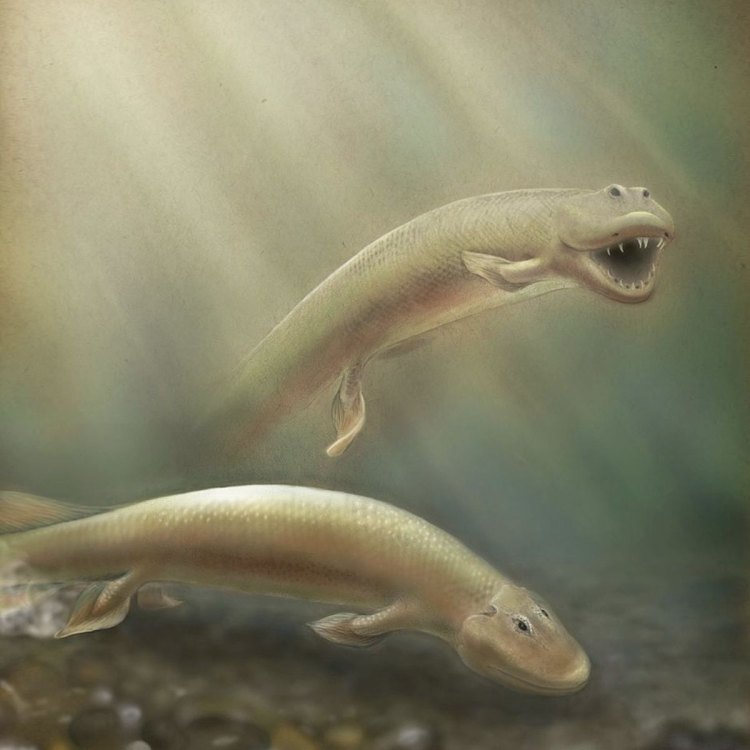
Tiktaalik
- Adult Size: Unknown
- Average Lifespan: Unknown
- Reproduction: Eggs
- Reproductive Behavior: Unknown
- Sound or Call: Unknown
- Migration Pattern: Unknown
- Social Groups: Unknown
- Behavior: Unknown
- Threats: Predation
- Conservation Status: Extinct
- Impact on Ecosystem: Unknown
- Human Use: None
- Distinctive Features: Fish with limb-like fins
- Interesting Facts: Tiktaalik is considered an important transitional species between fish and land-dwelling animals.
- Predator: Unknown
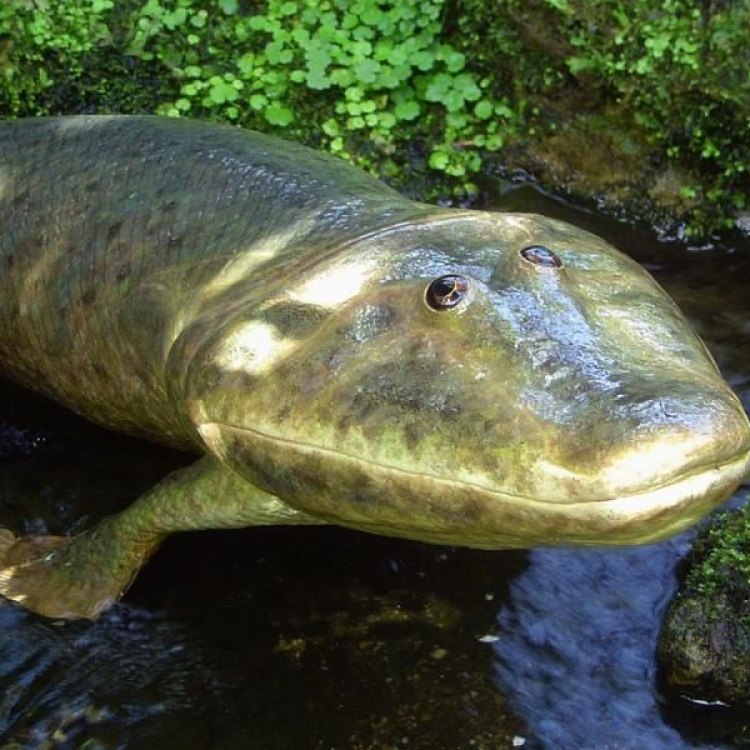
Tiktaalik
The Fascinating Story of Tiktaalik - The Missing Link Between Fish and Land-Dwelling Animals
From the vast depths of the ocean to the shores of the land, evolution has constantly shaped the animal kingdom. And in this continuous journey of evolution, certain species have played a crucial role in bridging the gaps between vastly different habitats.One such species that holds a special place in the history of evolution is Tiktaalik. This ancient creature, found in late Devonian deposits in the Canadian Arctic, has been hailed as the missing link between fish and land-dwelling animals PeaceOfAnimals.Com. Tiktaalik has fascinated scientists and the general public alike since its discovery in 2004. Let's dive into the story of this unique species and uncover the mysteries surrounding it.
The Basics: What is Tiktaalik
Tiktaalik, which means “large, freshwater fish” in the language of the Inuit, was a genus of fish that lived around 375 million years ago. It was one of the many species that inhabited the Earth during the Devonian period, also known as the "Age of Fishes". The interesting thing about Tiktaalik is that it had features of both fish and land-dwelling animals, making it a transitional species.The Life of Tiktaalik
Adult Size:The exact size of Tiktaalik is unknown since only partial skeletons have been found. However, based on the size of the fossils, scientists estimate that it was around 9 feet in length, making it one of the largest species in its ecosystem.
Average Lifespan:
As with its size, the average lifespan of Tiktaalik is also unknown. However, it is believed that it lived for several years, with some scientists estimating a lifespan of around 20 years Tapir.
Reproduction:
Like most fish, Tiktaalik laid eggs for reproduction. This was a common method of reproduction among most species during the Devonian period.
Reproductive Behavior:
Unfortunately, due to a lack of complete specimens, the reproductive behavior of Tiktaalik remains unknown. It is speculated that they may have laid their eggs in shallow waters and guarded them until they hatched.
Sound or Call:
Again, due to the incomplete remains, it is impossible to determine whether Tiktaalik produced any sounds or calls for communication.
Distinctive Features of Tiktaalik
One of the most distinctive features of Tiktaalik was its limb-like fins, which differentiated it from other fish of its time. These fins were sturdy and contained several bones, similar to the structure of limbs in land-dwelling animals. This indicated that Tiktaalik used its fins to move on the sea bottom, propelling itself forward as land-dwelling animals do with their limbs.Another unique feature of Tiktaalik was its flat skull and a pair of eyes positioned on the top, similar to that of crocodiles and other land-dwelling animals. This suggests that Tiktaalik had the ability to see above water while still being partially submerged, a crucial adaptation for its semi-aquatic lifestyle.
Behavior and Migration Patterns
Due to the incomplete remains, the behavior and migration patterns of Tiktaalik are unknown. Some believe that they may have been somewhat territorial, guarding their eggs and foraging in nearby waters. It is also speculated that Tiktaalik may have migrated to shallow waters during the breeding season, similar to modern-day fish.Tiktaalik's Impact on the Ecosystem
Being a top predator in its ecosystem, Tiktaalik played a crucial role in maintaining the balance of the food chain. As a semi-aquatic species, it would have fed on both marine and terrestrial animals, making it a crucial link between the two habitats.However, Tiktaalik's impact on the ecosystem goes beyond its role as a predator. Its unique features and adaptations were a significant contribution to the evolution of land-dwelling animals. Tiktaalik is believed to be the first creature to have developed the ability to support itself on its "limbs", a crucial step in the evolution of limbs in animals.
Tiktaalik's Discovery and Its Importance in Evolutionary History
Tiktaalik was discovered in 2004 in the remote Ellesmere Island in the Canadian Arctic by a team of paleontologists led by Neil Shubin. This discovery was the result of years of research and exploration, with the team searching for fossils in areas where they believed ancient rivers would have flowed.The discovery of Tiktaalik caused a sensation in the scientific community, as it offered the missing link between fish and land-dwelling animals. It provided evidence for the theory of evolution and the gradual transition from sea to land. Tiktaalik also challenged the traditional belief that certain groups of animals were created separately and independently. It showed that different species can evolve and share features, blurring the lines between different groups of animals.
Threats and Conservation Status
Sadly, the conservation status of Tiktaalik is "extinct". It is believed that climate change and the resulting changes in habitat were major factors in its extinction. As the Earth's climate changed and the seas receded, Tiktaalik's semi-aquatic lifestyle became unsustainable, leading to its eventual extinction.Human Use
Unlike other famous ancient species such as the dinosaurs, Tiktaalik did not have any significant contribution to human use. However, its discovery and study have helped scientists gain a better understanding of evolution and the development of limbs in animals. It has also inspired several works of art and literature, such as the graphic novel "Tiktaalik: Our First Fish" by French artist Sophie Goldstein.Interesting Facts About Tiktaalik
- Tiktaalik is considered one of the most important transitional species between fish and land-dwelling animals.- Its discovery was one of the best-documented fossil finds in history, with over 20 researchers and two crews of film-makers documenting the process.
- Tiktaalik shares features with both fish and land-dwelling animals, such as fins with limb-like bones and a flat skull with eyes on top.
- Its size, behavior, and adaptations place it as a top predator in its ecosystem.
- As a semi-aquatic species, Tiktaalik had the ability to live and hunt in both marine and terrestrial environments.
- Tiktaalik's discovery challenged the traditional belief of independent creation and offered evidence for the theory of evolution.
In Conclusion
Tiktaalik is a truly fascinating species that continues to captivate scientists and the general public. Its discovery provided crucial evidence for the theory of evolution, showcasing the gradual transition from water to land in animal species. As we continue to uncover more about the ancient world, Tiktaalik will remain a crucial piece of the puzzle, reminding us of the ever-changing nature of our planet and the diverse species that have inhabited it.
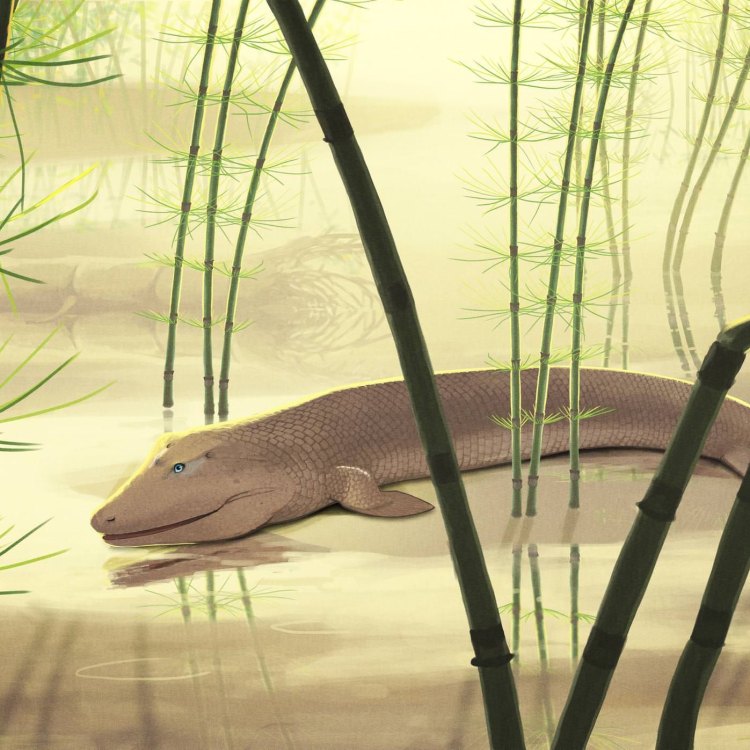
The Remarkable Tiktaalik: A Fascinating Transitional Fossil from Arctic Canada
Disclaimer: The content provided is for informational purposes only. We cannot guarantee the accuracy of the information on this page 100%. All information provided here may change without prior notice.









